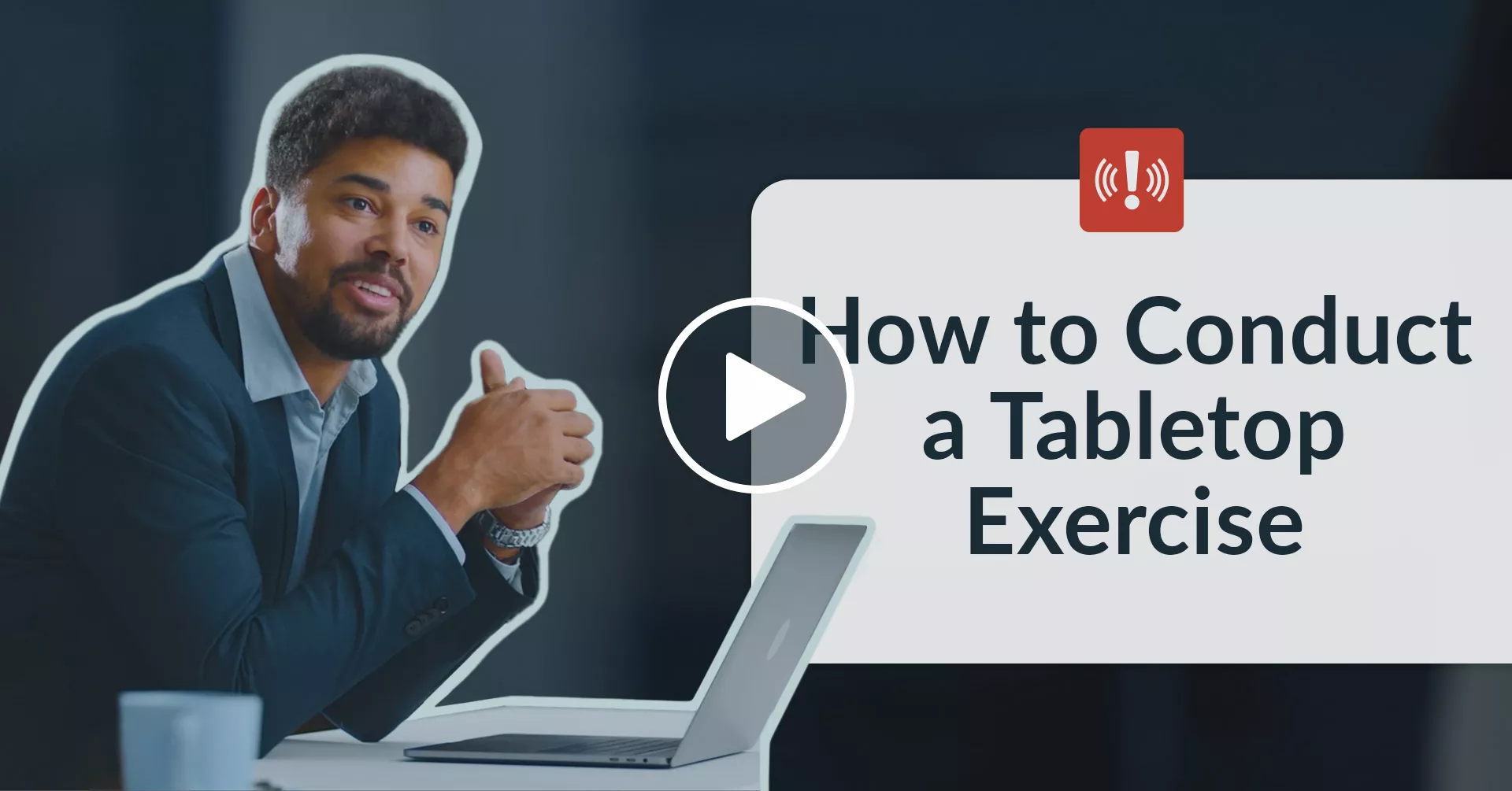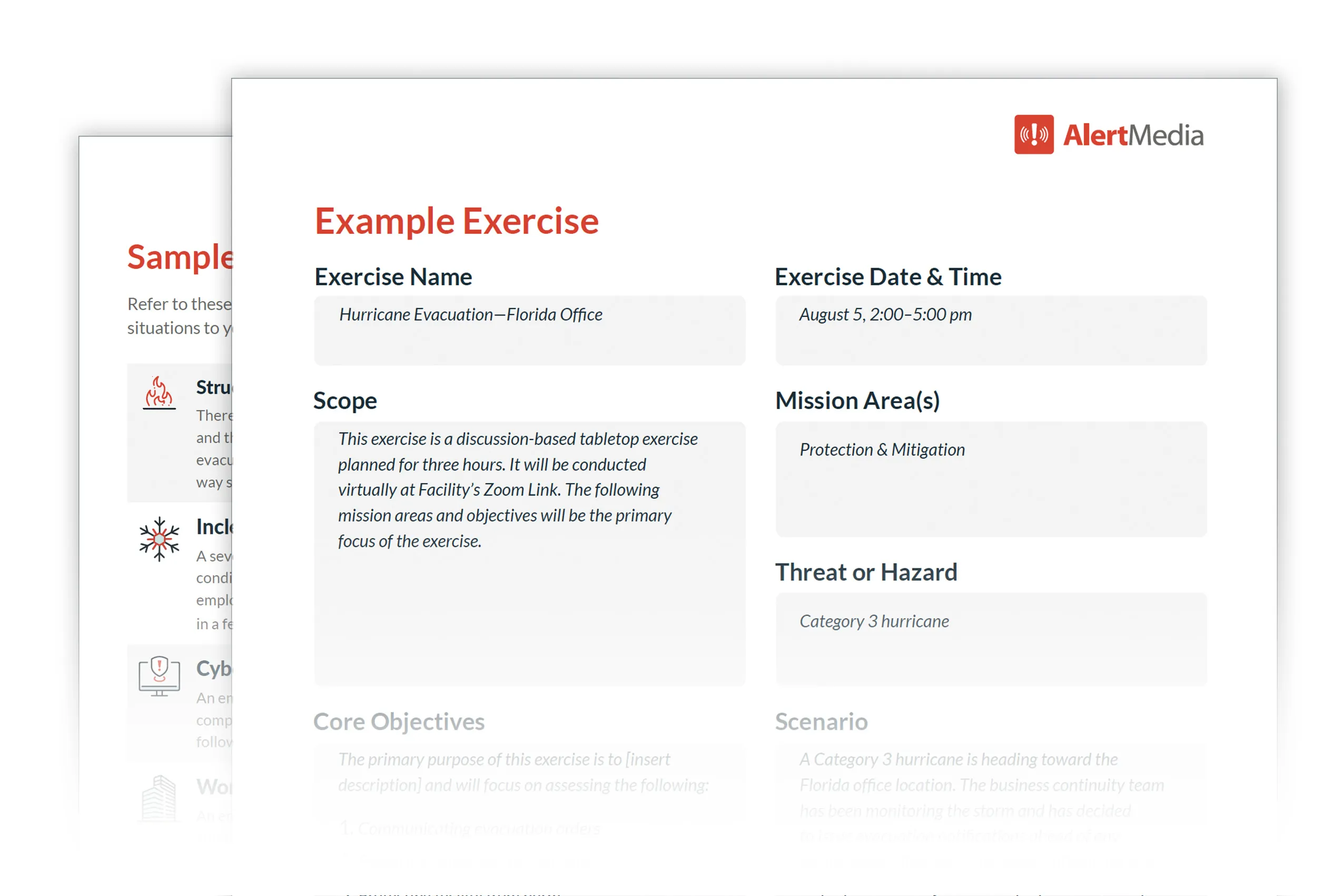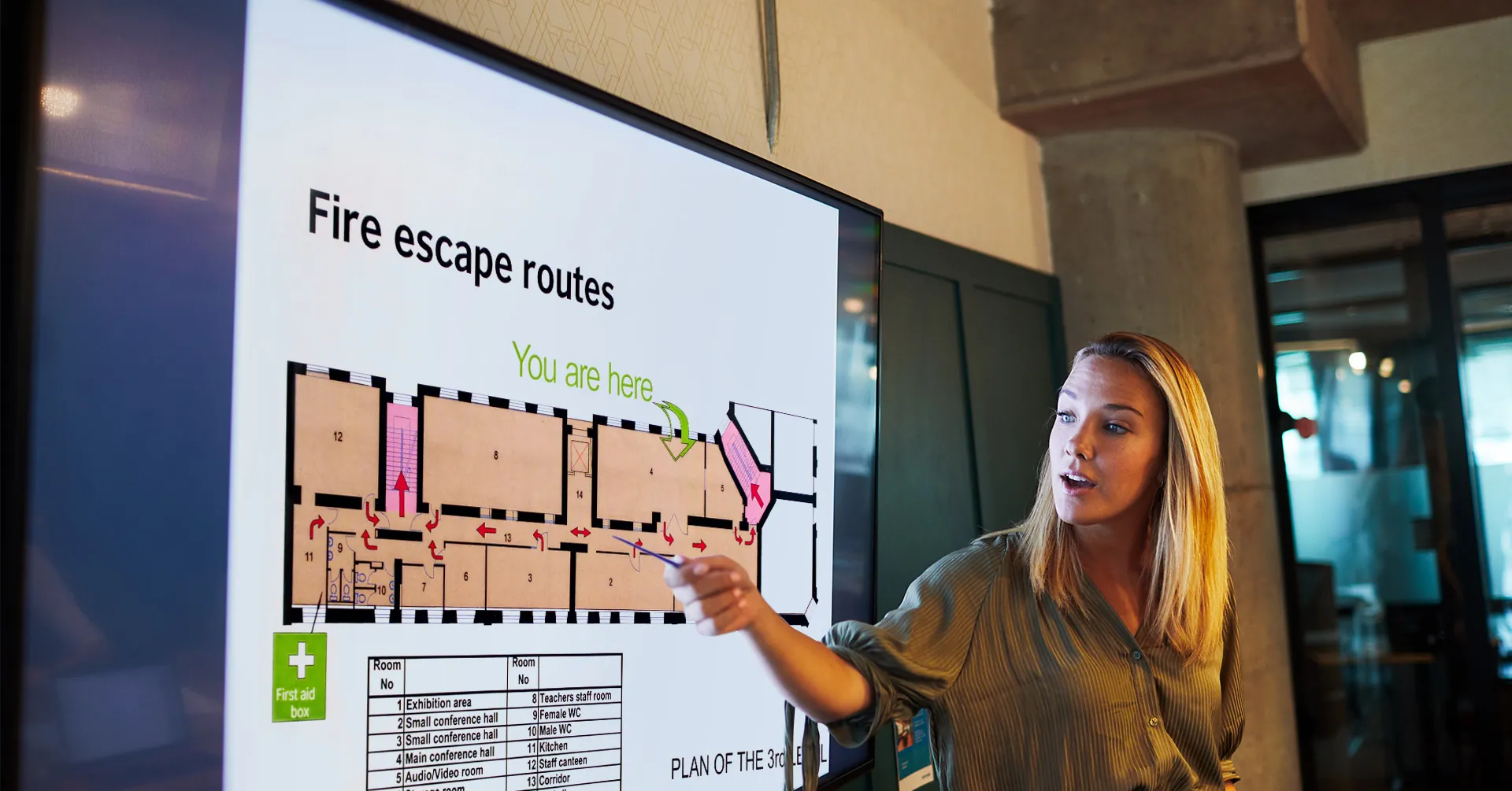
12 Tabletop Exercise Scenarios (+ Examples) to Level Up Your Preparedness
Use these tabletop exercise scenarios and examples to train your team to deal with high-stakes situations in a safe environment.

During an emergency that impacts your business, you want your response to run as smoothly as possible. So, practice is essential.
Training and drills are an integral part of proper emergency preparedness. These opportunities allow your emergency response team to get familiar with their responsibilities and your team members to get familiar with the procedures and processes that may save their lives.
However, running a full-scale drill can be incredibly disruptive and costly in terms of time and productivity. With tabletop exercises (TTX), you can supplement and even increase the effectiveness of drills and hands-on training.
These discussion-based, collaborative exercises can support your overall business continuity by engaging your employees’ problem-solving skills, identifying vulnerabilities, and establishing safe incident responses without the stakes or strain of a drill. It all comes down to choosing the right scenarios for your organization.
Whether you are just establishing your safety training program or simply looking for more ideas, here are 12 scenarios and a few full exercise examples you can use or adapt for your specific business needs.
Download Our Tabletop Exercise Template
How to pick the best tabletop exercise scenario
The overall success of your tabletop exercise depends on a well-planned scenario. You don’t want a scenario so broad you have a hard time coming up with specific responses, and you don’t want a scenario so narrow that your practiced response is not applicable to other situations. The key to finding the right fit is to pick a scenario that is realistic (i.e., it has enough detail and believability to represent actual events) and relevant (i.e., it is something your business could actually encounter) to your organization.
Performing a threat assessment is one great way to generate scenarios that will work well for tabletop exercises. You can also review your incident history to train your team on emergencies you’ve encountered in the past. There are also lots of online resources (such as this post itself) that can provide tabletop exercise scenario examples. All you have to do is tailor them with details specific to your organization.
12 Tabletop Exercise Scenarios to Practice With Your Team
You can practice your response procedures for a variety of threats with tabletop exercises. You might default to the most common threats your business faces, but those exercises won’t always be the most effective use of your time.
Some less common threats might actually have a significantly higher impact if they were to happen. So running exercises for those situations can help mitigate harm. Work with your stakeholders to build out your tabletop exercise plan. Here are a few scenarios to get you started preparing your employees for functional emergency response efforts.
Pro tip: Use a risk matrix to compare the likelihood and impact severity of various threat scenarios to help you prioritize your training exercises.
1. Structure fires
A fire in your business can be debilitating, and a fire evacuation plan is effective only when employees know what they need to do. Run tabletop exercises that take team members through the evacuation routes and various contingency plans so they are prepared for the unexpected.
Emergency examples:
- A kitchen fire
- An electrical malfunction
- An unsafe or blocked fire evacuation route
2. Inclement weather
With typical poor conditions or uncommonly severe weather, there is always the possibility that a storm or weather event could do significant damage to your business operations—whether through physical damage or by causing transportation/infrastructure issues. Design practice scenarios involving inclement weather so your business has the best chance of continuous operations, rain or shine.
Emergency examples:
- Downed power lines causing an outage
- Iced-over roads preventing travel
- Extreme heat above the safe threshold
3. Workplace injuries and accidents
The last thing you want is an employee hurt on the job and everyone standing around unsure of who to call. While general workplace safety and accident prevention are critical to emergency management, accident response should get just as much attention. After all, there is no way to prevent every workplace accident.
Emergency examples:
- Slips, trips, and falls
- First aid responses
- Health incidents like heart attacks
Workplace injury tabletop exercise example
Your healthcare facility, ABC Health Center, is a 200-bed hospital located in a busy urban area. The center provides a wide range of services and employs over 500 staff members.
Recently, the hospital has been undergoing renovations to upgrade its infrastructure and improve patient care areas. This has led to some temporary disorganization and an increased risk of accidents due to construction activities. The facility has strict safety protocols in place, including regular safety drills and mandatory reporting of hazards. However, the ongoing renovations have put additional pressure on maintaining these standards.
Incident: During a busy morning shift, a nurse slips on a wet floor in the hallway and sustains a serious injury, including a fractured wrist and a concussion. The nurse is immediately incapacitated and unable to continue her duties. A colleague witnesses the incident and promptly calls for medical assistance.
Immediate Actions: The injured nurse is taken to the emergency department for treatment, and the wet floor area is cordoned off to prevent further accidents.
Escalation: An internal investigation reveals that the floor was wet due to a leak from a nearby sink that had not been properly addressed. Further, the incident has caused significant concern among staff about workplace safety.
Discussion questions:
- Who will take over the injured nurse’s duties during her absence?
- How will you ensure that all potential hazards are promptly reported and addressed in the future?
- How will you inform the rest of the staff about the incident and any interim safety measures?
- What are the legal reporting requirements for this type of workplace injury?
- How will you document the incident and the subsequent investigation for regulatory compliance?

4. Cybersecurity incidents
Cybersecurity incidents are growing more and more common. Many businesses have simple training for things like creating safer passwords or spotting phishing attempts. But there are other types of cyberthreats you need to be prepared for, especially if you are in a high-security industry or you have sensitive data on customers or employees.
Emergency examples:
- Cloud storage and data breach
- Malware or ransomware attack
- Third-party cyberattack on a critical vendor
5. Workplace violence
Violence in the workplace is a jarring threat that nobody really feels prepared for. However, training can help prevent panic and keep your employees safer in the event of an incident. Don’t limit your training to extreme situations alone. Some of the most common workplace violence comes from angry customers or clients or even disgruntled former employees. Situational awareness training is a big part of successful prevention and response.
Emergency examples:
- Active shooter scenarios
- Threats from customers or clients
- Domestic violence incidents
6. Business travel disruptions
If you have traveling employees, tabletop exercise scenarios can be an important component of travel risk management. Travel can inject countless complications into already challenging and dangerous scenarios because so few variables are in your control. Use a tabletop exercise to ensure your team knows how to stay safe in a different environment.
Emergency examples:
- Flight delay or cancellation for a critical staff member
- Foreign insurgency or civil unrest
- Pandemic or related travel restrictions
7. Natural disasters
Every business location has its own natural disasters to contend with. As these events become more frequent and more intense with climate change, you need to be ready with a response and recovery plan long before the hurricane approaches or the wildfire sparks up. You should also practice how you would respond if a disaster affects any critical third-party vendors or even important customers.
Emergency examples:
- Gas shortage from an offshore hurricane
- Secondary fire from an earthquake
- Extreme drought
Natural disaster tabletop exercise example
Blue Bistro is a popular restaurant chain with 15 locations spread across the East Coast. The chain is known for its casual dining experience and high-quality food. Each location typically has a seating capacity of 100–150 guests and employs around 30 staff members.
The East Coast, particularly the northeastern states, is not typically prone to tornadoes. However, due to changing climate patterns, there has been an increase in severe weather events, including rare out-of-season tornadoes.
Incident: It is early November, and a sudden, severe weather alert is issued warning of a tornado forming near one of the coastal cities where Blue Bistro operates three locations. Despite the unusual timing and location, the National Weather Service confirms the presence of a rapidly developing tornado.
Notification: Local authorities issue an emergency tornado warning, advising residents and businesses to take immediate shelter. Staff at all three affected Blue Bistro locations receive alerts through the emergency broadcast system and their personal devices.
Immediate actions: The on-duty managers at each location initiate the emergency response plan, directing staff and customers to the designated safe areas within the restaurants (e.g., interior restrooms, storage rooms, and basements).
Aftermath: The tornado hits the city, causing significant damage to infrastructure and buildings, including the three Blue Bistro locations. One location sustains major structural damage while the other two experience moderate damage, such as broken windows, roof damage, and interior flooding. Power outages and disruptions to transportation infrastructure further complicate the situation.
Discussion questions:
- How will the managers ensure the safety of all staff and customers during the tornado?
- How will you communicate with staff, customers, executive stakeholders, and emergency services during and after the incident?
- What steps will you take to assess the damage to each of the affected locations?
- How will you coordinate with insurance providers and emergency services for immediate recovery efforts?
- What measures can be implemented to improve preparedness for tornadoes and similar unexpected events in the future?
8. Power outages
Even a short power outage can halt business operations, disrupt communication, and pose safety hazards. And these events often occur as a result of another emergency such as a severe storm, increasing the complexity of your response. Tabletop exercises can help guide your employees through emergency procedures, setting up alternative power sources, and communicating through the outage.
Emergency examples:
- A city-wide blackout during peak business hours
- An unexpected power failure due to a severe storm
- A prolonged outage caused by damage to the local power grid
9. Supply chain disruptions
For many businesses, a resilient supply chain is critical for operational success. Disruptions can be crippling if your team struggles to navigate these challenges and implement contingency plans to minimize impacts.
Emergency examples:
- A key supplier experiencing a manufacturing shutdown
- Transportation delays due to severe weather conditions
- A sudden shortage of critical materials or components
Supply chain tabletop exercise example
Your company, XYZ Manufacturing, relies heavily on a key supplier for a critical component used in one of your best-selling products. This component is sourced from a manufacturer located overseas. The lead time for this component is typically four weeks, and you maintain a safety stock of two weeks’ worth of inventory.
Incident: You receive an urgent email from the supplier informing you that their factory has been severely damaged by a natural disaster, and they expect a minimum six-week delay in production.
Initial impact: Your current inventory will last only two weeks, after which production will halt.
Escalation: The supplier informs you that the delay might extend to eight weeks due to logistical challenges in their region.
Discussion questions:
- What are the first steps your team will take upon receiving the notification?
- How will you communicate this disruption to your stakeholders, including customers and internal teams?
- What are your options for finding an alternative supplier?
- How will you manage customer expectations and communicate potential delays?
- What steps will you take to prevent similar disruptions in the future?
10. Political demonstrations
Political demonstrations can introduce disruptions from transportation delays to violent threats. It’s essential to have a plan in place to handle such events while ensuring the safety and security of everyone involved, particularly if you operate near high-profile locations.
Emergency examples:
- A peaceful protest that escalates unexpectedly
- A demonstration blocking major access routes to your business
- An increase in security threats due to heightened political tensions
11. IT outage
An IT outage, whether due to cyberattacks or system failures, can be a major disruption to critical business functions. Ensuring your team knows how to respond to IT failures is vital for maintaining operations and protecting sensitive information. Create scenarios that simulate various technology outages, and outline the steps to restore functionality.
Emergency examples:
- A ransomware attack locking down company systems
- A server failure resulting in data inaccessibility
- A network outage affecting all remote and on-site operations
12. Concurrent emergencies
In many cases, emergency situations will stack on top of each other, so you are forced to manage several concurrent issues. This can significantly strain your resources and complicate your response efforts. Your team must be prepared to handle overlapping emergencies efficiently. Conduct tabletop exercises that simulate scenarios where two or more emergencies occur simultaneously to ensure your team can manage complex situations.
Emergency examples:
- A natural disaster with prolonged power outages
- An IT outage occurring during a severe weather event
- A critical health incident happening while your business is dealing with a structure fire
More Resources on Tabletop Exercises
Tips for Running Effective Tabletop Exercises
Now that you have an idea of types of exercises you should do with your employees, here are a couple of tips to help make the process as easy and productive as possible.
Take advantage of templates
Preparing for emergencies is complicated enough without having to create brand-new documents every time you want to run a training session. Use a tabletop exercise template to streamline the process. Your facilitator can use them to keep track of exercise objectives, how well the participants followed the plan, and any other notes that might be helpful.
Use GenAI to build exercises
Choosing the perfect scenario to train is a small first step; you’ll still need to build out the full tabletop exercise. That process can take a significant amount of time and energy—something you may not have an excess of. But there are plenty of ways that tools like generative AI can help with this process. AI can help add specific details or novel injects, as well as industry-standard questions or best practices you may not be aware of. And it can help you save precious time in drafting.
Shane Mathew, a consultant at Stone Risk Consulting, found that generative AI not only saved him time when he was creating tabletop exercises but also created better, more impactful exercises. “My scenarios went from being just functional to impressively immersive, truly putting participants in the throes of a crisis. This newfound skill did more than just meet deadlines; it started to wow our clients,” he explained in an article. “The realism and depth that I was able to achieve with AI’s help started to set our exercises apart from the rest, making them not just drills, but key learning experiences that could be directly applied in real-world situations.”
Document your performance
Keeping track of how your tabletop exercises go is a great way to improve your response performance over time. An after-action report can help you review, reflect, and learn from any mistakes you made during the exercise. You can then create tactical plans to improve future response efforts.
Engage Team Members in Safety Plans for Lasting Outcomes
No matter what kind of emergency you are preparing for, having a team of leaders and employees who feel ready to respond in a safe manner will ensure your business isn’t leveled by a critical event. Training in a safe environment to build muscle memory around a response plan is a great way to create a successful safety culture.






